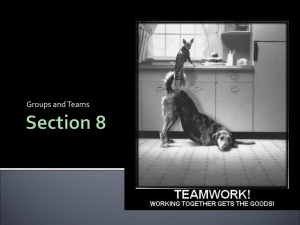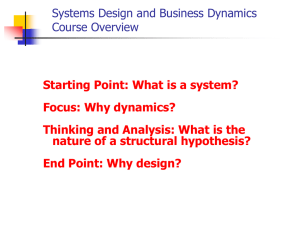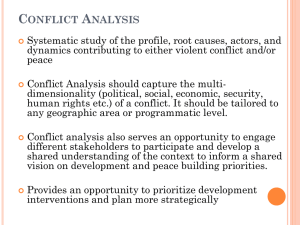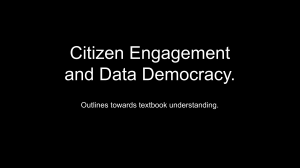Presentation - University of Washington
advertisement
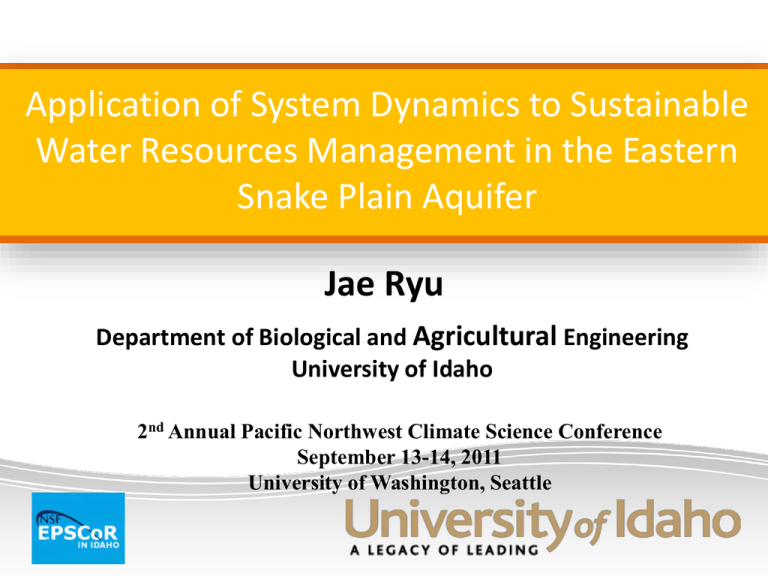
Application of System Dynamics to Sustainable Water Resources Management in the Eastern Snake Plain Aquifer Jae Ryu Department of Biological and Agricultural Engineering University of Idaho 2nd Annual Pacific Northwest Climate Science Conference September 13-14, 2011 University of Washington, Seattle Acknowledgement 1. Bryce Contor, Water Economist Idaho Water Resources Research Institute 2. Gary Johnson, Geologist Department of Geological Sciences 3. Richard Allen, Water Resources Engineer Department of Biological and Agricultural Engineering 4. John Tracy, Director Idaho Water Resources Research Institute Outline • Motivation • Eastern Snake Modeling Efforts • System Dynamics • Future work I MISS GLOBAL WARMING Decadal mean surface temperature anomalies relative to base period 1951-1980. Source: update of Hansen et al., GISS analysis of surface temperature change. J. Geophys. Res.104, 30997-31022, 1999. Greenhouse gas concentrations are increasing, Average global temperature has increased warming will continue Water resources impacts are inevitable Climate change impacts • Federal – – – – U.S. Bureau Reclamation (USBR) U.S. Geological Survey (USGS) U.S. Army Corps of Engineers (USACE) Natural Resources Conservation Service (NRCS-USDA) • State – Idaho Department of Water Resources (IDWR) – Idaho Department of Environmental Quality (IDEQ) – Idaho Fish and Game Commission (IFGC) • Private – – – – – Idaho Power (IP) Irrigation Districts (IDS) Agricultural Producers (APS) Aquaculture Industries (AI) Surface/Groundwater Irrigators (SGI) ESPAM (MODFLOW-Groundwater Model) VIC (Vegetation Infiltration Capacity Model) Snake River Planning Model (SRPM) Movement: MODSIM POWERSIM RIVERWARE GIS-Based Accounting Model (IDWR) GFLOW (Conceptual Groundwater Model) GAMS (General Algebraic Modeling System) Policy-Driven Decision Making Adaptive Management Options Water Dispute Resolution Sustainable Water Resources Planning and Management Policy-Driven Decision Making Adaptive Management Options Water Dispute Resolution Sustainable Water Resources Planning and Management System Dynamics System Dynamics • Inspired by Jay W. Forrester at MIT based on system dynamics concepts in the 1950’s in modeling economic processes • Implemented concepts in software early (1960’s), e.g. SIMPLE, DYNAMO, MODSIM, POWERSIM, VENSIM • Stella is software that implements the system dynamics approach to modeling Why Stella? • Stella modeling environment has been used in many water resources applications • Simple to complex systems • Very flexible and user-friendly • Transparent and easy to understand • Ideal for collaborative building process • Transferability • Great education tool as well System Dynamics • Casual Loop Diagram (Cause and Effect) (+) Birth Rate + + Population System Dynamics • Casual Loop Diagram (Cause and Effect) Death Rate + (-) - Population System Dynamics • Casual Loop Diagram (Cause and Effect) (+) Birth Rate + + + (-) Population - Death Rate System Dynamics Example 2: Bath Tub Example 2.0 gal. per min 25 gallons, half full 5.0 gal. per min How long does it take to be completely empty? System Dynamics • Stock and Flow Diagram (Cause and Effect) + − Figure 2. Flow in the Snake River is strongly affected by irrigation diversions and by inflow from springs (after Kjelstrom, 1986) System Dynamics in ESPA Surface Water Entity: 60 Groundwater Entity: 10 Tributary Reach: 22 Non-Snake Stream: 22 Snake Reach: 6 Precipitation Recharge (Rock, Thick, Thin): 3 System Dynamics in ESPA • Surface water irrigation (SW) SW D R P ET * K CL Where, D=Diversion, R=Return, P=Precipitation, ET=Evapotrans, K=ET adj. factor, CL=Canal losses • Ground water pumping (GP) GP P ET • Canal losses (CL) CL (1 / c) * D * F * M Where, C=# of model cell (Canal only), D=Diversion, F=Seepage fraction, M=Calibrated multiplier System Dynamics Causal relationships in the ESPA of surface and ground water flux exchange Natural System Human System System Dynamics • Stock and Flow Diagram (Cause and Effect) Recharge Discharge Evaluation Criteria • System Reliability (97% threshold) S T Where, α =System reliability (probability), T= Total outputs (success and failure), S= the set of all satisfactory outputs • System Vulnerability (magnitude) s jej jF Where, β=Vulnerability indicator, s= the most unsatisfactory (severe impacts) among failures, e=probability of S in failure set • System Resiliency (Back to normal) Where, γ=resiliency, α= system reliability lim n Where, ϕ=probability of system recovery t Wt =1 when random event Xt is failure and Xt+1 is sucess; otherwise Wt =0 W n t 1 (Hashimoto et al., 1982; Ryu et al., 2009) Supply/Demand Scenarios Supply (Climate change) • No climate change • 10 % surface decrease (placeholder) • 20 % surface decrease (placeholder) • 10 % surface increase (placeholder) • 20 % surface increase (placeholder) Demand (Adaptive management) • No action • 5 % groundwater curtailment • 10 % groundwater curtailment • 20 % groundwater curtailment Planning Horizon (2100) Adaptive management Results • Climate Impacts on the ESPA • A variety of management options to minimize water conflicts among stakeholders • Evaluate planning alternatives in shared vision modeling framework Future Work • Water Rights (Legal binding) • Ecological Modeling (Water quality, temperature, aquatic culture, biology, etc) • Economic Consequences (O&M Cost, Delivery Cost, Pumping Cost, Commodity Analysis: GAMS) Questions/Comments ESPAM, RECHARGE Model Coupled Climate-Hydrology Model Accounting Model (IDWR) Network Flow (MODSIM) Agricultural Economic Model

